by Alex Bolques | Sep 23, 2013
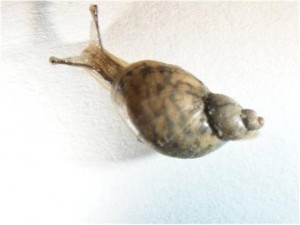
Cone Shaped or Cone Shell Snail Photo Credits: Heather M. Young, Biological Scientist, NFREC-Quincy
Occasionally on shipments of container plants, snails (terrestrial air-breathing gastropods) may be found attached to the container pot. Snails are abundant in nearly all parts of the world except the arctic regions, and feed almost entirely on vegetation. Those mostly encountered on nursery container plants are cone shaped reaching 1/2 to 2 1/2 inches in length and having an external enclosing spiral shell or occasionally rounded shell with four to five rapidly expanding whorls that are 1 to 1 1/4 inches in size.
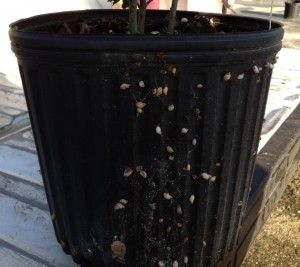
Image Credit: Henry Grant, Gadsden County Extension.
There are many species of snails. Most snails found on shipments are those restricted to tropical and semitropical regions requiring high humidity and warm temperatures. The U.S. has four native genera of Bulimulidae: Rhabdotus, Drymaeus, Orthalicus and Liguus. Of these, the last three genera are native to Florida. There is also another introduced genus in Florida, Bulimulus, which is primarily terrestrial. Other introduced species are Zachrysia provisoria and Caracolus marginellus in the Family Camaenidae occurs in Florida and found throughout much of the tropics.
Snails are also found in moist, shaded locations, which are similar to conditions found in container plant production areas, weedy locations or in organic trash. Most lay eggs throughout the season. Overwintering eggs may hatch in spring.
The following are general snail management suggestions:
- Remove excess organic material under plants. Organic materials provide moist hiding places for eggs and smaller snails, and sometimes as food sources.
- Monitor plant and environment moisture to reduce favorable snail habitats.
- When possible, remove the snails by hand, which is a reasonable, effective, nontoxic and environmentally acceptable control option.
- Check with your favorite garden store outlet for bait, biological, or chemical product control options.
For more information check out this gardening in a minute segment on snails and slugs.
by Taylor Vandiver | Aug 12, 2013
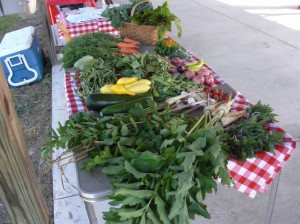
Consumers worldwide are rediscovering the benefits of buying locally grown food. However, this notion is not necessarily new. Farmers have been making their freshly produced wares available at local locations for years.
So, why should anyone buy local? Local produce is considered fresher, tastier, and more nutritious. Studies have shown that fresh produce loses nutrients quickly during transportation. During the trip from harvest to dinner table, sugars in the plants turn to starches, plant cells shrink, and produce loses its vitality. Food grown in the local community was probably picked within the past day or two and, therefore, is much fresher. It is also good for the local economy.
Buying directly from family farms helps them stay in business. Less than 1% of Americans now claim farming as their primary occupation, which isn’t surprising considering that today’s farmer gets less than 10 cents of the retail food dollar. Local farmers who sell directly to consumers get full retail price for their produce. Buying local decreases the likelihood of urbanization and increases the diversity of produce available locally.
As the value of direct-marketed fruits and vegetables increases, selling farmland for development becomes less likely. Also, rural farming areas can serve as a habitat for many species of wildlife. Buying local produce proactively preserves the agricultural landscape. By supporting local farmers today, you can help ensure that there will be farms in your community tomorrow, that there will be a habitat for wildlife, and that future generations will have access to locally produced food.
How can you be involved in this resurging concept, you might ask? One of the many ways you can provide support, while gaining fresh produce, is to join a CSA. The term CSA stands for Community Supported Agriculture. It involves one or more farmers, and many individuals or families, from a community who pledge financial support to a farm operation. The farmers and consumers share the risks and benefits of food production. Members are considered “share-holders” of the farm and they generally pledge in advance to cover the anticipated costs of the farm operation and farmer’s salary.
In return for their commitment, consumers receive “shares” or a regular portion of what has been harvested from the farm throughout the different growing seasons. There are risks associated with farming that affect both the farmer and the shareholder, including poor harvests due to unfavorable weather or pests. By selling directly to their community farmers receive better prices for their crops, gain some financial security, and are relieved of much of the burden of marketing. Members benefit because they receive a wide variety of fresh, local produce harvested at the peak of freshness and flavor. If you would like to find a CSA in your community you can visit the local harvest website.
There are numerous other opportunities to be involved in supporting local agricultural operations. A good place to start would be to make a visit to your local Extension office. The agents there can help point you in the right direction, whether you want to start your own farming operation or simply provide fresh produce for your home.
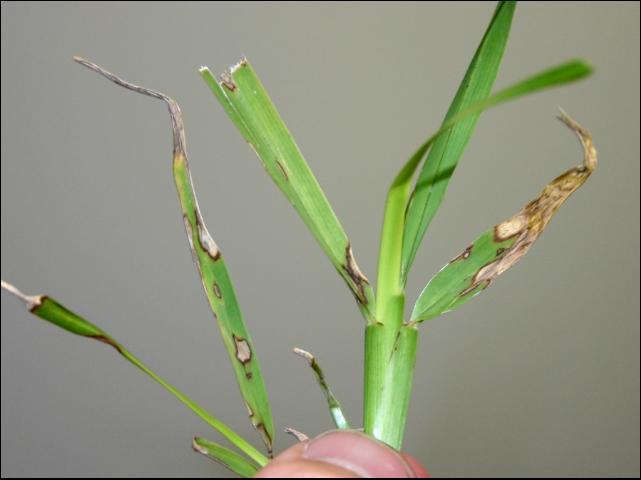
by Larry Williams | Jul 22, 2013
Gray Leaf Spot is a common fungal disease of St. Augustinegrass. Recent wet conditions have promoted this disease. This includes high humidity, heavy dews and particularly frequent afternoon and evening rains.
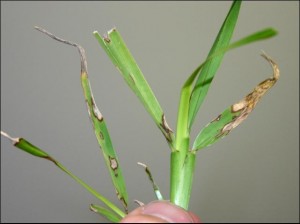
Gray leaf spot symptoms on St. Augustinegrass. Photo credit: UF/IFAS Extension
The individual spots or lesions are first seen as tiny brownish spots smaller than a pinhead. As they become larger, they will be circular and then begin to elongate lengthwise along the leaf. The spots will become brown to grayish in appearance. Numerous spots or lesions may be found on an individual leaf. Heavily infected leaves begin to turn brown and wither, usually beginning at the tip of the blade.
Gray leaf spot can move rapidly during prolonged warm, wet periods. Over watering or irrigating in the evening provides the prolonged period of wetness required for disease infection. For more information on how to correctly water a Florida lawn, visit the UF / IFAS Lawn Watering Website.
According to the Florida Lawn Handbook, “Severity of the disease is enhanced by application of readily available nitrogen fertilizer and is proportional to the amount of nitrogen applied.” Select fertilizers that are low in nitrogen or that have slow release nitrogen. Be careful to not overdo it in fertilizing your lawn and do not apply a high nitrogen fertilizer on top of an already infected lawn. Also, some lawn weed killers such as atrazine will increase the susceptibility of the grass to gray leaf spot.
Irrigate during early morning hours to minimize the period in which the grass is wet and water only on an as needed basis, watering less often but deeply. Avoid frequent, shallow watering and don’t irrigate when the lawn is already wet from rain. With the recent frequent rains, very little to no supplemental irrigation has been needed on most lawns in our area. Avoid leaving irrigation timers on when adequate rainfall has occurred. It’s best to operate irrigation controllers on manual so that the lawn can be monitored and irrigation provided during dry times.
If the disease outbreak is severe, fungicide may be needed. Look for products containing propiconazole, triadimefon or thiophanate-methyl. Always follow the product’s label directions and precautions.
For more information on maintaining a Florida lawn, contact your County UF/IFAS Extension Office or visit the YourFloridaLawn Website.
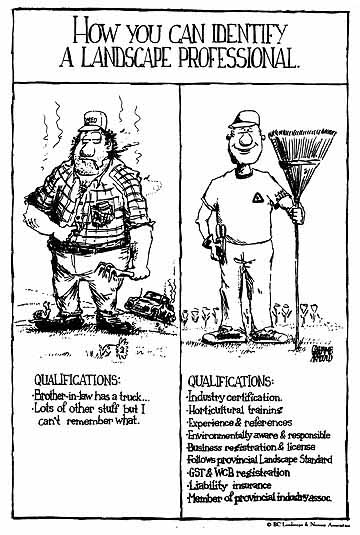
by Sheila Dunning | Jul 15, 2013
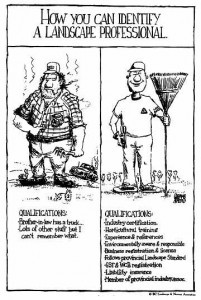 On June 18, 2009, Florida Governor Charlie Crist signed into law SB 494 requiring all commercial fertilizer applicators have a license by January 1, 2014. Passing the Green Industries Best Management Practices (GI-BMP) training is mandatory to obtain that license. University of Florida/IFAS Extension provides training and testing programs in urban landscape management practices and issues certificates demonstrating satisfactory completion of the training. These classes are available in English or Spanish.
On June 18, 2009, Florida Governor Charlie Crist signed into law SB 494 requiring all commercial fertilizer applicators have a license by January 1, 2014. Passing the Green Industries Best Management Practices (GI-BMP) training is mandatory to obtain that license. University of Florida/IFAS Extension provides training and testing programs in urban landscape management practices and issues certificates demonstrating satisfactory completion of the training. These classes are available in English or Spanish.
After receiving a certificate of completion, a person must pay $25 and apply to receive a limited certification for urban landscape commercial fertilizer application. A person possessing such a certification is not subject to additional local testing. The certification expires 4 years after the date of issuance.
Using UF/IFAS-recommended application rates and timing of pesticides, fertilizer and irrigation can help prevent nonpoint source pollution (water pollution that is associated with everyday human activities and driven by rainfall, runoff and leaching) from urban landscapes. By choosing plants appropriate for the site and maintaining them with correct cultural practices (irrigation, fertilization, mowing and pruning), one can significantly reduce the amount of water a landscape needs to thrive.
The GI-BMP class teaches landscape workers how to implement these Best Management Practices into their daily work. This is an opportunity for Green Industry workers to complete this requirement and market their skills to clientele. Trainings are available monthly across the Panhandle as well as on-line. Visit the website for more information : FYN-GI-BMP WEBSITE. UF / IFAS Washington County Extension will be offering a GI-BMP class July 23rd. Follow this link for registration information.
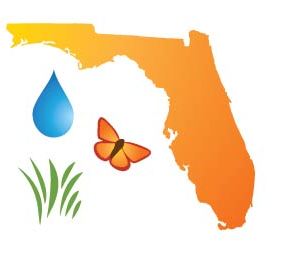
by Blake Thaxton | Jun 4, 2013

As of January 2014 all companies applying fertilizer, commercially “for hire”, will be required to hold a fertilizer applicators license. In order to obtain this license you must first become GI-BMP certified.
2014 isn’t that far away. Take the time to attend class this summer. Don’t wait to the last minute and have to scramble to find a training close to home.
What are Green Industries Best Management Practices?
GI-BMPs teach environmentally safe landscaping practices that help conserve and protect Florida’s
ground and surface waters and natural resources. This science-based educational program for
Green Industry professionals is brought to you by the UF/IFAS Florida-Friendly LandscapingTM
program and the Florida Department of Environmental Protection. Other FAQs about GI-BMPs
June 28th – Santa Rosa County
Navarre Community Center: 1917 Navarre School Rd Navarre, FL 32566
For more information email Blake Thaxton at bthaxton@ufl.edu









